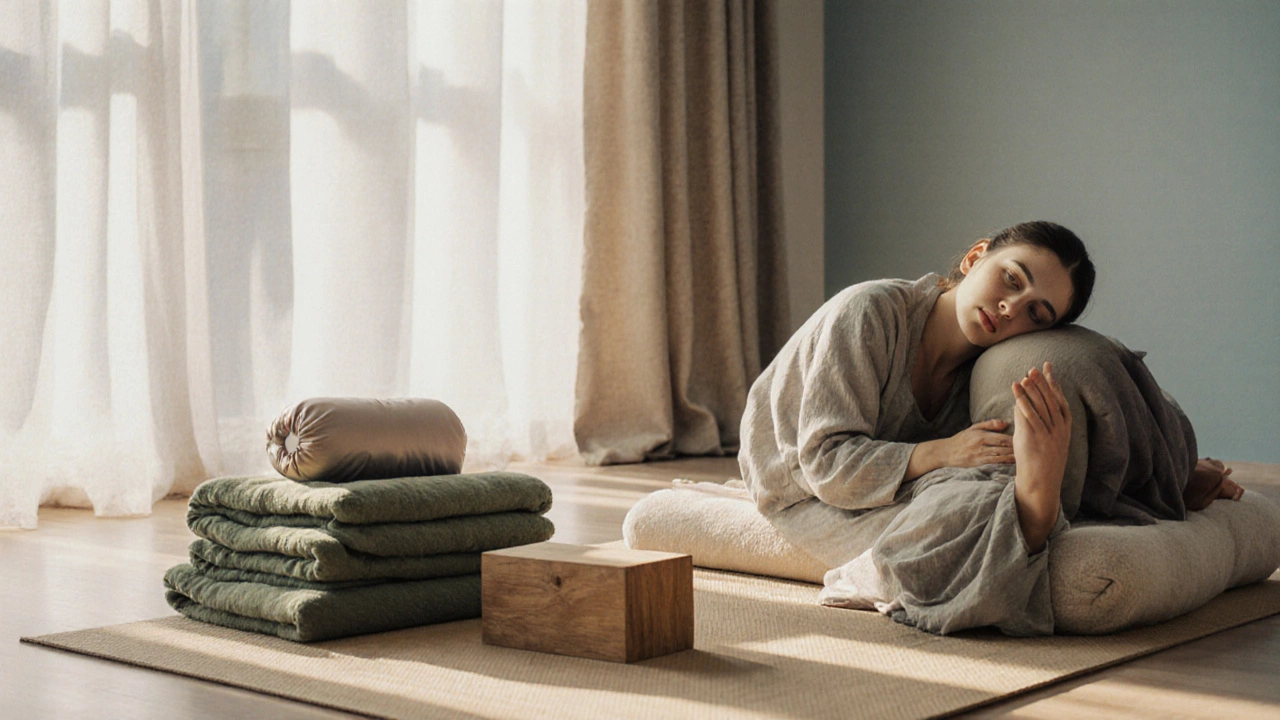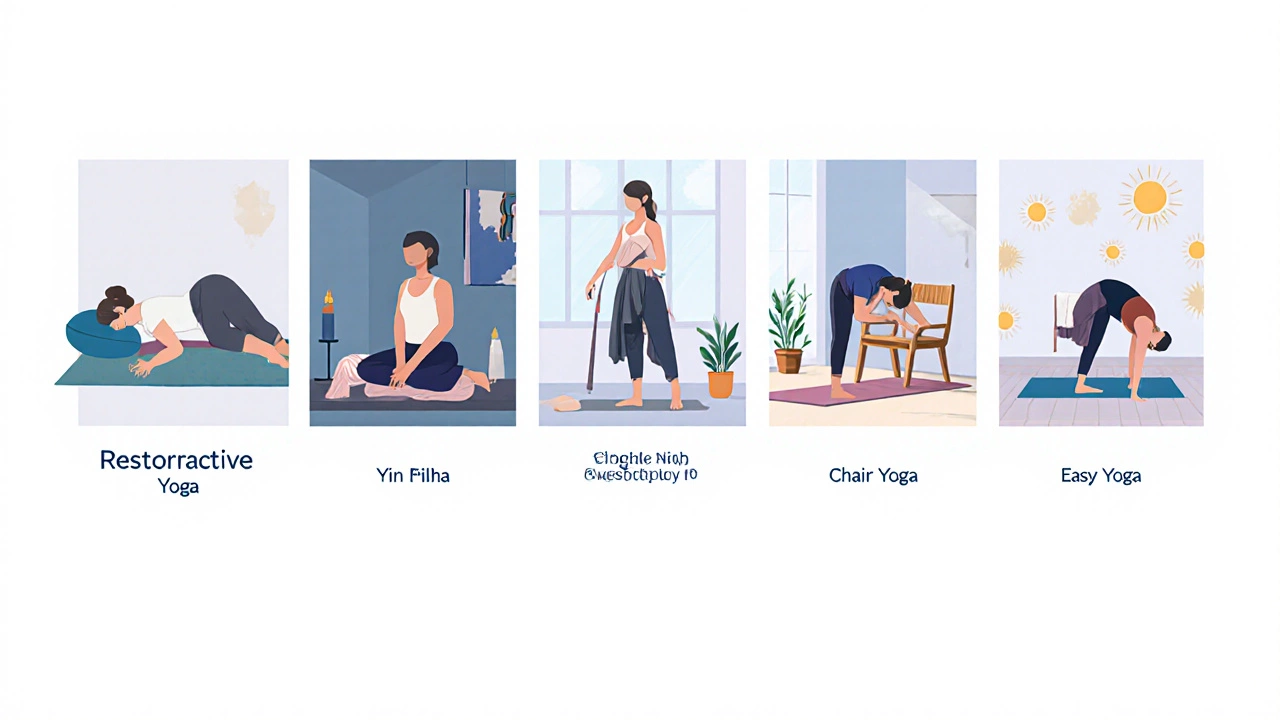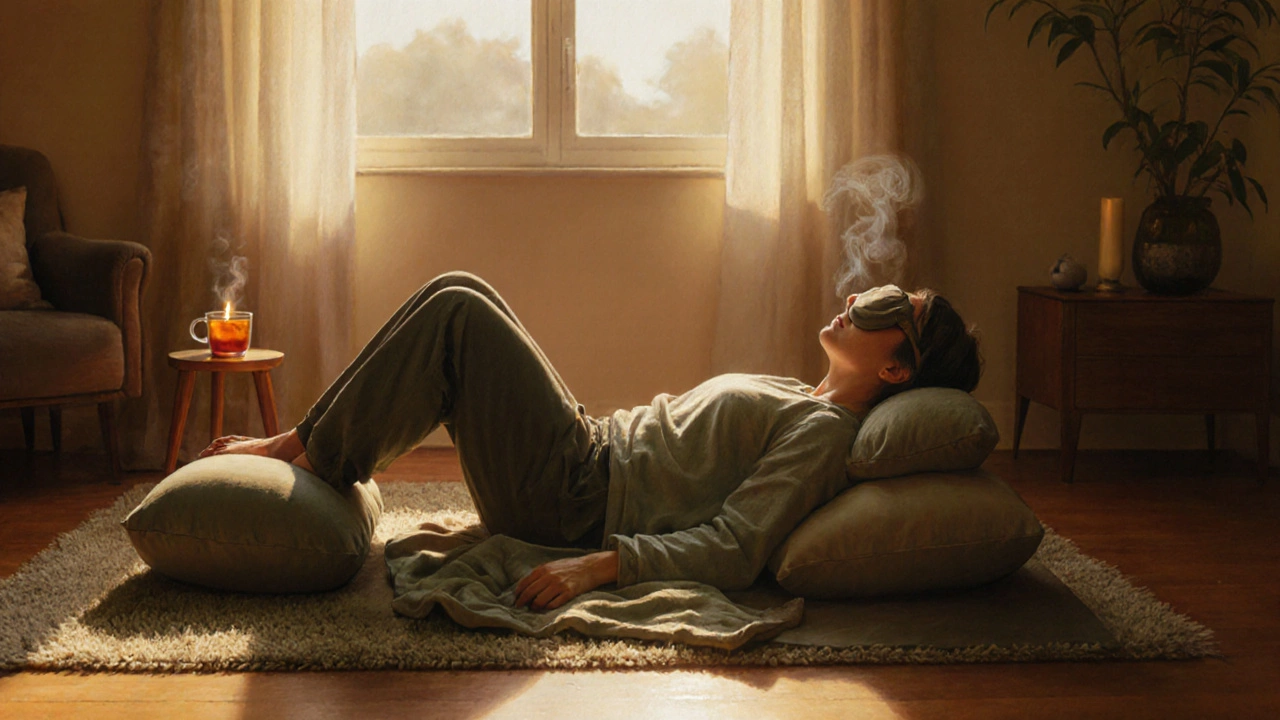
Gentle Yoga Style Selector
Recommended Gentle Yoga Style
| Style | Intensity | Typical Pose Hold | Props Required | Ideal For |
|---|---|---|---|---|
| Restorative Yoga | Very low | 5-15 min | Bolster, blanket, block, eye pillow | Chronic pain, anxiety, recovery |
| Yin Yoga | Low | 2-5 min | Blanket, block (optional) | Deep connective-tissue release, meditative focus |
| Gentle Hatha | Low-moderate | 30-60 sec per pose | Block, strap (optional) | Beginner flexibility, mild cardio |
| Chair Yoga | Very low | 30-90 sec | Sturdy chair | Seniors, office workers, injury rehab |
| Easy Flow Yoga | Low | 1-2 min | None (optional block) | Time-pressed adults, stress relief |
Quick Take
- Restorative yoga is widely regarded as the gentlest yoga style.
- Yin, gentle Hatha, and chair yoga are also very low‑impact alternatives.
- Key factors are intensity, use of props, and focus on relaxation rather than strength.
- Choose a style that matches your mobility, injury history, and stress‑reduction goals.
- A typical gentle session lasts 20‑45 minutes and can be done daily.
What Does "Gentle Yoga" Mean?
In everyday language, "gentle yoga" refers to any practice that minimizes strain on muscles and joints while emphasizing breath, softness, and mental calm. It isn’t a single brand‑named discipline; rather, it’s a collection of styles that share three core traits:
- Low physical intensity - poses are held for short periods or supported with props.
- Minimal impact on the autonomic nervous system - the practice aims to activate the parasympathetic (relaxation) branch.
- A focus on mindfulness and stress reduction over strength or flexibility gains.
Because the definition is broad, the "gentlest" form often depends on personal health conditions and the environment you practice in. For most readers, the answer will point to the style that combines the softest movements with the greatest support.
Restorative Yoga: The Softest of All
Restorative Yoga is a low‑impact practice that uses props such as bolsters, blankets, and blocks to fully support the body in passive poses. Sessions typically last 30‑90 minutes, with each pose held 5‑15 minutes. The goal is not to stretch aggressively but to invite the nervous system into deep relaxation.
Research from the Journal of Alternative and Complementary Medicine (2023) found that a single 45‑minute restorative class reduced cortisol levels by 30% and improved sleep quality among office workers. The style’s reliance on props means that even people with limited mobility can stay comfortably on the floor.
Key attributes of restorative yoga include:
- Intensity: Very low
- Props needed: bolsters, blankets, blocks, eye pillow
- Typical session length: 30‑90 minutes
- Best for: chronic pain, anxiety, recovery from intense training
Other Low‑Impact Yoga Styles
While restorative yoga tops the list for softness, several other styles sit close behind. Below is a quick snapshot of each.
Yin Yoga focuses on long, passive stretches held for 2‑5 minutes, targeting deep connective tissue is often labeled "meditative" because it blends stillness with a slow breath. The intensity is still low, but the poses target the hips, spine, and thighs, offering a mild stretch sensation.
Gentle Hatha offers a traditional Hatha flow with simplified transitions and optional props keeps moving but avoids deep backbends or intense balancing. It’s a good bridge between a seated meditation and a full‑body workout.
Chair Yoga adapts classic yoga poses to be performed while seated or using a chair for support is ideal for seniors, office workers, or anyone who finds floor work challenging. The intensity is minimal, and the props are the chair itself.
Even Easy Flow Yoga provides a gentle sequence of standing and seated poses linked by breath, without jumps or rapid transitions can qualify as gentle when instructed at a slow pace.

How to Pick the Right Gentle Yoga for You
Choosing the best style isn’t a one‑size‑fits‑all decision. Consider these three practical criteria:
- Physical limitations: If you have joint pain or limited mobility, prioritize fully supported practices like restorative or chair yoga.
- Time available: Restorative sessions need longer blocks (30‑90min), while gentle Hatha or easy flow can fit into a 20‑minute window.
- Goal focus: For stress relief, restorative and yin have strong evidence; for mild flexibility gain, gentle Hatha shines.
Ask yourself: "Do I want to unwind completely, or do I also want a whisper of movement?" Your answer will point you toward the most suitable style.
Sample Gentle Yoga Session (Restorative Focus)
Below is a beginner‑friendly 30‑minute restorative routine. All poses are fully supported; you only need a bolster, a folded blanket, and an eye pillow.
- Supported Child’s Pose - Place a bolster in front of you, sit back onto your heels, and stretch your torso over the bolster. Rest for 5 minutes, breathing deeply.
- Supported Reclining Bound Angle - Lie back, bring the soles of your feet together, and slide a blanket or bolsters under each thigh. Hold for 7 minutes.
- Supported Bridge - Place a block under your sacrum, let your arms relax at your sides, and stay for 5 minutes.
- Legs‑Up‑the‑Wall - Move to a wall, sit with your hips close to it, swing your legs up, and support your lower back with a folded blanket. Stay for 8 minutes.
- Savasana with Eye Pillow - Let your body melt into the floor, cover your eyes, and stay for the remaining 5 minutes.
Notice how each pose requires no active muscular effort - the props do the work, allowing the nervous system to reset.
Common Pitfalls & How to Avoid Them
Even gentle practitioners slip into habits that erode the softness of the practice. Here are three frequent mistakes and quick fixes:
- Skipping Props: Trying to hold poses without support can turn a restorative class into a strenuous workout. Always have your bolsters and blankets within arm’s reach.
- Rushing the Breath: Gentle yoga thrives on slow, diaphragmatic breathing. If you find yourself panting, pause and lengthen each exhale.
- Staying Awake: The deep relaxation can make you drowsy. Use an eye pillow and keep the room slightly cool to stay alert yet calm.
Comparison of the Softest Yoga Styles
| Style | Intensity | Typical Pose Hold | Props Required | Ideal For |
|---|---|---|---|---|
| Restorative Yoga | Very low | 5‑15min | Bolster, blanket, block, eye pillow | Chronic pain, anxiety, recovery |
| Yin Yoga | Low | 2‑5min | Blanket, block (optional) | Deep connective‑tissue release, meditative focus |
| Gentle Hatha | Low‑moderate | 30‑60sec per pose | Block, strap (optional) | Beginner flexibility, mild cardio |
| Chair Yoga | Very low | 30‑90sec | Sturdy chair | Seniors, office workers, injury rehab |
| Easy Flow Yoga | Low | 1‑2min | None (optional block) | Time‑pressed adults, stress relief |
Next Steps: Integrating Gentle Yoga Into Daily Life
Take a pragmatic approach. Start with a 20‑minute gentle Hatha or chair session three times a week. After two weeks, add a once‑weekly restorative class to deepen relaxation. Track how you feel - sleep quality, stress levels, joint comfort - and adjust the frequency accordingly.
If you’re new to props, invest in a good-quality bolster (about 10‑12inches thick) and a couple of firm blankets. They’re inexpensive, last years, and make every gentle style more accessible.
Remember, the gentlest yoga isn’t about doing the least; it’s about doing exactly what your body and mind need at that moment. With the right style, you’ll discover a sustainable practice that leaves you feeling calm, flexible, and ready for whatever comes next.

Frequently Asked Questions
Is restorative yoga suitable for people with chronic back pain?
Yes. Because the poses are fully supported, restorative yoga removes pressure from the spine while encouraging gentle lengthening of the back muscles. Many clinics prescribe it as part of a pain‑management program.
Do I need a yoga mat for gentle yoga?
A mat is helpful for comfort, but it’s not mandatory. For fully supported styles like restorative or chair yoga, a soft carpet or a folded blanket works just fine.
How often should I practice gentle yoga to see stress‑relief benefits?
Studies show that 2‑3 sessions per week, each lasting 20‑30 minutes, can lower cortisol within a month. Consistency beats intensity for stress reduction.
Can I combine gentle yoga with a regular HIIT routine?
Absolutely. Use gentle yoga as a recovery day or as a cool‑down after HIIT. The low‑impact nature helps restore the nervous system and reduces muscle soreness.
Do I need a teacher for restorative yoga, or can I do it alone?
While a certified teacher can guide prop placement, many beginners start with online videos that demonstrate safe setups. Just ensure you’re using sturdy props and listening to your body.
